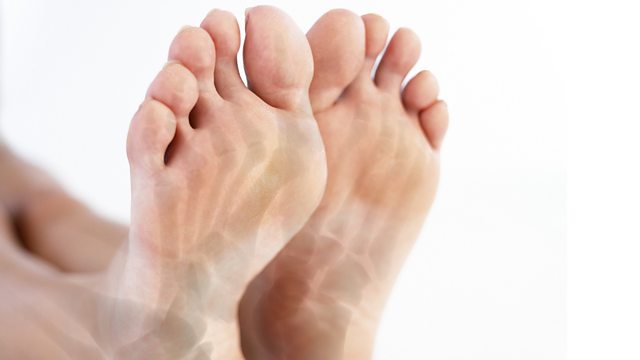Feet
The challenges the human foot faces, from ballerinas dancing on points to the Chinese tradition of footbinding. With poet Wang Ping, Jim Usherwood and Patrick Rump.
Why do adult humans walk like ostriches, but toddlers walk like turkeys? How can the analytical methods of sports science help to prevent ballet dancers from injuring their feet? And how were Chinese women with bound feet still able to labour in the fields? Bridget Kendall finds the answers to these and many other foot-related questions with the help of poet Wang Ping, sports scientist Patrick Rump and locomotion researcher Jim Usherwood.
Last on
Chapters
-
Jim Usherwood
Biomechanics of the human foot
Duration: 09:32
Wang Ping
Footbinding in China
Duration: 11:45
60 Second idea
Get rid of money and go barefoot
Duration: 04:27
Patrick Rump
Using sports science to treat ballet dancers
Duration: 12:42
Jim Usherwood
![Jim Usherwood]()
Jim UsherwoodΒ is Wellcome Trust Senior Research Fellow and Reader at the Structure and Motion Laboratory in the Department of Comparative Biomedical Sciences at the Royal Veterinary College.Β Jim's research interests cover the mechanics of both terrestrial and aerial locomotion. He is finishing a project on the mechanics of walking in birds and toddlers, and is currently part of the team working on cooperative aerodynamics and radio-based animal localisation CARDyAL.
Wang Ping
![Wang Ping]()
Wang Ping is author of 13 books of poetry, prose, translation, including Aching for Beauty: Footbinding in China. Sheβs also a photographer, dancer, and installation artist. Her most recent multi-media exhibition βWe Are Waterβ at the Soap Factory included 100 artists from the Yangtze and Mississippi Rivers. She is professor of English at Macalester College, founder and director of Kinship of Rivers project. Her memoir: Flying: Life of Miracles between the Yangtze and Mississippi, is forthcoming from Calumet Press in February 2015.
(Photo: Macalester College /Sara Rubinstein)
Patrick Rump
![Patrick Rump]() Patrick Rump is a sports scientist notable for his recent work with ballet dancers. He currently works for the Royal Ballet and has worked with the Forsythe Company. His work is now the subject of a short film, Dance Sports Science and Patrick Rump. His method - applying the techniques of sports science to dancing - has had much success, including in his contribution to the recovery of acclaimed Royal Ballet ballerina, Alina Cojocaru, as well as other world-famous principals such as Mathias Heymann and Federico Bonelli, and Tamara Rojo. Patrick is from Germany. He is a former karate champion.Β
Patrick Rump is a sports scientist notable for his recent work with ballet dancers. He currently works for the Royal Ballet and has worked with the Forsythe Company. His work is now the subject of a short film, Dance Sports Science and Patrick Rump. His method - applying the techniques of sports science to dancing - has had much success, including in his contribution to the recovery of acclaimed Royal Ballet ballerina, Alina Cojocaru, as well as other world-famous principals such as Mathias Heymann and Federico Bonelli, and Tamara Rojo. Patrick is from Germany. He is a former karate champion.Β60 Second Idea to Change the World
![60 Second Idea to Change the World]() Letβs free ourselves from money and shoes.Β Wang Ping puts forward her idea in the form of a poem.Β She wants everyone around the world to give up money for a day and adopt a system of gift exchange β βa song for food, a house for danceβ¦.a poem or story to move us from place to placeβ.Β In her vision we would go physically and metaphorically barefoot β in touch with each other and the earth.Β Freed from the shackles of business transactions and free to play.
Letβs free ourselves from money and shoes.Β Wang Ping puts forward her idea in the form of a poem.Β She wants everyone around the world to give up money for a day and adopt a system of gift exchange β βa song for food, a house for danceβ¦.a poem or story to move us from place to placeβ.Β In her vision we would go physically and metaphorically barefoot β in touch with each other and the earth.Β Freed from the shackles of business transactions and free to play.
(Photo: Burning a bank note. Credit: Getty Images)Broadcasts
- Mon 5 Jan 2015 03:05GMTΒιΆΉΤΌΕΔ World Service Online
- Tue 6 Jan 2015 09:05GMTΒιΆΉΤΌΕΔ World Service Online
Do you think political or business leaders need to be charismatic? Or do you prefer highly competent but somewhat stern people?
Podcast
-
![]()
The Forum
The programme that explains the present by exploring the past







